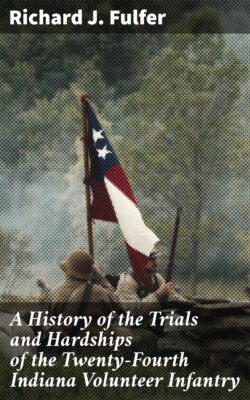Читать книгу A History of the Trials and Hardships of the Twenty-Fourth Indiana Volunteer Infantry - Richard J. Fulfer - Страница 10
CHAPTER I.
ОглавлениеThe Twenty-fourth Indiana regiment was one of the first called for as three years’ volunteers. We were enrolled on the 9th day of July, 1861, to serve for three years, if not sooner discharged. We were mustered into service July 31st, 1861, at Camp Knox, which is near Vincennes, Indiana.
Our first camp life after being enrolled was a new mode of living and sport. Some of the boys had never been very far from our homes, and were not posted in the pranks and tricks of the times, even in those early days.
We soon drew a few old Harper’s Ferry muskets. We had a string guard around the camp. Company drill was held four hours each day. This was the only amusement which we had in the daytime, but at night we had magicians, sleight of hand performers, and others who made amusement for some of us who had never seen many shows. The tall man and elephant also paraded through the quarters at night, and this furnished a great deal of amusement for us.
We got our uniforms August 7th. They were gray and were about as appropriate as our old Harper’s Ferry muskets. The guards soon beat the stocks off of the muskets and bent the ends of the barrels. These they used as canes.
Getting used to camp life was quite a change for some of us who had been raised up on corn bread, hominy and buttermilk. There was also a change in the bill of fare. We now had hard tack, sow belly, and black coffee. There were many other changes of life which must be made to make us a happy, united family.
The weather was very warm at this time, and we soon began to think that army life was no soft snap.
On the 16th of August we again drew arms. These were new Harper’s Ferry muskets. Six Enfield rifles were allowed to each company.
On the next day we marched through the city of Vincennes on review. All was a hurry and excitement, as the troops were being sent to the front on that day.
We got marching orders on the 18th, and we got on board a train bound for East St. Louis, Ill. We arrived there on the morning of the 19th. We crossed the Mississippi river on the steamer “Alton City,” marched two and a half miles through the city of St. Louis, Mo., and went into camp in the Lafayette Park. Here were the first tents we ever pitched, and all the boys wanted to learn how.
Lafayette Park is a beautiful park. It contains many fine animals. There were many of our boys who had never seen such sights as the city of St. Louis contained. Some of them had sore eyes on account of so much sight-seeing.
There were many regiments in camp at this park at the same time we were there.
In a short time we struck tents and marched down the river a distance of seven miles. We went into camp at Carondelet. One of the officers named this camp, Camp Allen.
August 27th, Colonel Alvin P. Hovey took command of our regiment. He soon commenced battalion drill, which was very hard on us, owing to the warm weather. We had battalion drill four hours each day and company drill two hours, so you see that we were somewhat busy.
September 6th, Colonel Hovey, with six of our companies, boarded a train on the Iron Mountain railway and made a trip of twenty-five miles. We left the cars at 8 o’clock p. m. and made a rapid march of several miles out through a very rough, broken country. At 5 o’clock in the morning we got orders to lie down on our arms for a little rest, but not to speak above a whisper and to be ready to fall in line at a minute’s notice. When morning came we learned that the rebels had evacuated their camps and skipped. Thus we were knocked out of a fight at this place. On account of not having any rebels to shoot at, we could do nothing else but march back over the roughest roads we had ever marched on.
Here was our first experience in foraging off of the country. But we got a plenty on this trip, such as cream, honey and peaches—all of which were good things that we could not get in camp.
This trip was called the Betty Decker march. I don’t know why this name was given it unless she was the lady who furnished us so many good things for our suppers.
We got back to the railroad at 8 p. m., got aboard a train, and at 10 o’clock arrived at our camp at Carondelet.
While here we had to guard the dry docks while the ironclad vessels, St. Louis and Carondelet were being built. It was rumored that these vessels would be blown out of existence before they were finished, and as half of the people in St. Louis were ready to do anything for the Southern cause, we believed it. But nevertheless they were completed and had an active part in putting down the rebellion.
While we were drilling and guarding at this place we could see other regiments at Benton Barracks who were strengthening their fortifications. Now was the time when something had to be done to invade Missouri.
